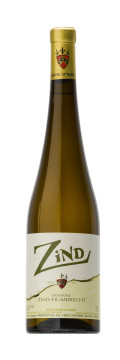
Technical presentation
| Bottling : | February 2017 |
|---|---|
| Acquired alcohol : | 12.5 ° |
| Residual sugar : | 3.1 g/l |
| Total acidity : | 3.7 g/l H2SO4 (5.7 g/l Tartrique) |
| pH : | 3.2 |
| Yield : | 33 hl/ha |
| Optimum tasting : | 2022-2033 |
| Average age of vines : | 28 years |
| Terroir : | Clos Windsbuhl |
| Sweetness index : | 1 |
| Soil : | Muschelkalk calcareous, South East facing |
Description of the wine Zind 2017
The Zind is traditionally made from our Chardonnay (70%) and Auxerrois (30%) vineyard located on the limestone soil of the Clos Windsbuhl in Hunawihr. In 2017, we added a small fraction of Auxerrois from the Rotenberg vineyard (10%) because the crop was so small it would have been complicated to vinify these grapes separately. (Pinot-Blanc and Auxerrois on the valley floor of Turckheim were completely destroyed by the frost, so we didn’t produce any Pinot-Blanc 2017). The grapes in Hunawihr were beautiful, small and very healthy. The dry extract in the wines of 2017 is high and this probably explains the very slow fermentation for most wines (15 months). It was a relief to see it going on to the end, resulting on a dry wine.

Tasting notes
02/2019 : Pale yellow colour. The nose is already nicely expressive, showing citrus, wet stone and fruits. The wine keeps on opening after bottling. The palate is elegant and makes the wines so easy to enjoy. The texture is supple, juicy and sapid. The Zind 2017 finds its harmony around an interesting contrast between acidity and weight. The finish is saline and textbook Windsbuhl in character. It will keep !

The Clos Windsbuhl of Hunawihr
The altitude of the vineyard coupled with Hunawihr’s tardy climate means that the Clos Windsbuhl is often one of the last of our vineyards to be harvested. This explains the aromatic quality of the Clos’ wines and the consistent balance of acidity, a guarantee of good ageing. Although often harvested late, the Windsbuhl grapes are only rarely botryitized, doubtless due to the altitude of the vineyard, but nevertheless often reach high levels of maturity.